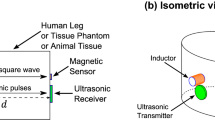Abstract
With an ultrasonic method tissue layer thickness was measured in man in circumscribed superficial tissue areas where the underlaying bone provided good backwall echos. In a 5 mm tissue layer changes of ±0.2% could be reliably detected. Knowing the height of the tissue cylinder between the surface of the skin and the bone allowed to calculate the tissue volume. The ultrasonic probes could therefore serve as miniature plethysmograph. Several probes were attached in the frontal region, sternum, along the vertebral column and along the tibia simultaneously. Changes of the volume content of the superficial shell tissues were induced by orthostasis, water immersion and heat exposure. It was possible to assess quantitatively the volume shifts into or out of the superficial tissues. During orthostasis 166 ml of fluid left the superficial tissues of the cephalad parts of the body and 164 ml could be traced in the dependent parts. Heat exposure was followed by a pooling 140 ml in the tissues studied. The most pronounced tissue volume changes were observed in the forchead region during heat exposure.
Similar content being viewed by others
References
Arborelius, M., Jr., Balldin, U. L., Lilja, B., Lundgren, C. E. G.: Hemodynamic changes in man during immersion with the head above water. Aerospace Med.43, 592–598 (1972)
Epstein, M.: Renal effects of head-out water immersion in man: Implications for an understanding of volume homeostasis. Physiol. Rev.58, 529–581 (1978)
Folkow, B., Heymans, C., Neil, E.: Integrated aspects of cardiovascular regulation. In: Handbook of physiology Sec. 2, circulation (W. F. Hamilton, Ph. Dow, eds.), Vol. III, pp. 1787–1823. Washington, D.C.: American Physiological Society 1965
Gauer, O. H., Thron, H. L.: Postural changes in the circulation. In: Handbook of physiology Sect. 2, circulation, Vol. III (W. F. Hamilton, Ph. Dow, eds.), pp. 2409–2439. Washington, D.C.: American Physiological Society 1965
Greenfield, A. D. M., Whitney, R. J., Mowbray, J. F.: Methods for the investigation of peripheral blood flow. Br. Med. Bull.19, 101–109 (1963)
Guyton, A. C., Jones, C. E., Coleman, Th. G.: Cardiac output and its regulation, p. 183 and p. 365. Philadelphia, London, Toronto: W. B. Saunders 1973
Knebel, R., Ockenga, T.: Das Verhalten des zentralen Venendrucks beim Kipptischverversuch. Z. Kreisl. Forsch.49, 235–250 (1960)
Lange, L., Lange, S., Echt, M., Gauer, O. H.: Heart volume in realtion to body posture and immersion in a thermo-neutral bath. A röntgenometric study. Pflügers Arch.352, 219–226 (1974)
Ludbrook, J.: Aspects of venous function in the lower limbs. Springfield, Ill.: Ch. C. Thomas 1966
Risch, W. D., Koubenec, H.-J., Beckmann, U., Lange, S., Gauer, O. H.: The effect of graded immersion on heart volume, central venous pressure, pulmonary blood distribution, and heart rate in man. Pflügers Arch.374, 115–118 (1978)
Rowell, L. B.: Human cardiovascular adjustments to exercise and thermal stress. Physiol. Rev.54, 75–159 (1974)
Rowell, L. B.: Competition between skin and muscle for blood flow during excrcise. In: Problems with temperature regulation during exercise (Ethan R. Nadel, ed.), pp. 49–76. New York, San Francisco, London: Academic Press Inc. 1977
Sachs, L.: Angewandte Statistik, Planung und Auswertung. Methoden und Modelle, 4. Aufl. Berlin, Heidelberg, New York: Springer 1974
Sjöstrand, T.: The regulation of the blood distribution in man. Acta Physiol. Scand.26, 312–327 (1952)
Thauer, R.: Circulatory adjustments to climatic requirements. In: Handbook of physiology Sec. 2, circulation (W. F. Hamilton, Ph. Dow, ed.), Vol. III, pp. 1921–1966. Washington, D.C.: American Physiological Society 1965
Thornton, W. E., Hoffler, G. W., Rummel, J. A.: Anthropometric changes and fluid shifts. Proceedings of Skylab Life Science Symposium, August 27–29, 1974. NASA TM X-58154, November 1974, II, pp. 637–658
Whitney, R. J.: Circulatory changes in the forearm and hand of man with repeated exposure to heat. J. Physiol. (Lond.)125, 1–24 (1954)
Wilkins, R. W., Bradley, S. E., Friedland, C. K.: The acute circulatory effects of the head-down position (negative G) in normal man, with a note on some measures designed to relieve cranial congestion in this position. J. Clin. Invest.29, 940–949 (1950)
Yamakoshi, K.-I., Shimazu, H., Togawa, T., Ito, H.: Admittance plethysmography for accurate measurement of human limb blood flow. Am. J. Physiol. Sec. Heart Circulat. Physiol.235, H821-H829 (1978)
Author information
Authors and Affiliations
Additional information
This study was supported by the Deutsche Forschungs- und Versuchsanstalt für Luft- und Raumfahrt e. V., Köln
A preliminary report was given at the 49th Congress of the German Physiological Society, Göttingen, March 1978 [Pflügers Arch.373, R 24, 25 (1978)]
Rights and permissions
About this article
Cite this article
Kirsch, K.A., Merke, J., Hinghofer-Szalkay, H. et al. A new miniature plethysmograph to measure volume changes in small circumscribed tissue areas. Pflugers Arch. 383, 189–194 (1980). https://doi.org/10.1007/BF00587517
Received:
Accepted:
Issue Date:
DOI: https://doi.org/10.1007/BF00587517




